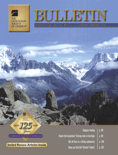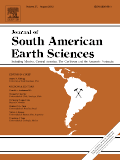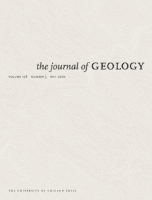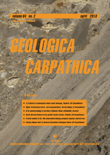
EARTH SCIENCES HISTORY
Scope & Guideline
Illuminating the Philosophical Roots of Earth Sciences
Introduction
Aims and Scopes
- Historical Geology:
Investigates the evolution of geological theories and practices over time, including the contributions of significant figures and milestones in the field. - Mining and Mineralogy History:
Explores the historical context of mining practices, mineral discoveries, and the development of mineralogy as a scientific discipline. - Women in Earth Sciences:
Highlights the roles and contributions of women in the field of earth sciences, emphasizing their historical significance and impact on scientific advancements. - Military Geology:
Examines the intersections between geology and military operations, particularly during significant historical events such as World Wars. - Cultural and Societal Influences:
Analyzes how geological knowledge has influenced and been influenced by cultural, societal, and environmental contexts throughout history. - Stratigraphy and Paleontology:
Focuses on the historical development of stratigraphic principles and paleontological discoveries, contributing to our understanding of Earth's history.
Trending and Emerging
- Interdisciplinary Approaches:
There is a growing trend towards interdisciplinary studies that integrate geology with history, sociology, and cultural studies, enriching the understanding of earth sciences in historical contexts. - Global Perspectives on Geology:
Recent publications indicate an increasing focus on global geological narratives, examining the interconnectedness of geological developments across different regions and cultures. - Biographical Studies of Geologists:
An emerging theme is the biographical exploration of influential geologists, shedding light on their contributions and the historical context of their work. - Impact of Climate Change on Historical Geology:
The relevance of historical geology in understanding contemporary climate change issues is gaining traction, linking past geological events to current environmental challenges. - Digitization and Historical Data:
The use of digital tools and archives to explore and present historical geological data is becoming more prevalent, facilitating broader access and analysis of historical records.
Declining or Waning
- Modern Geological Techniques:
The historical analysis of modern geological techniques and technologies has become less prominent, possibly due to a shifting focus towards historical narratives rather than contemporary methodologies. - Contemporary Environmental Geology:
There has been a noticeable reduction in discussions surrounding contemporary environmental geology and its historical context, which may be overshadowed by current environmental crises. - Geological Controversies:
Although debates and controversies in geology have been a staple, recent publications suggest a waning interest in historical controversies, perhaps as the field matures and settles into established narratives. - Regional Geology Studies:
Studies focused on specific regional geological histories have decreased, potentially in favor of broader, more global perspectives on geological developments. - Geological Education History:
The exploration of the history of geological education appears to be less frequent, indicating a possible shift towards practical applications and current educational methodologies.
Similar Journals

GEOLOGICAL SOCIETY OF AMERICA BULLETIN
Exploring the Depths of Earth's MysteriesThe Geological Society of America Bulletin (GSA Bulletin), with ISSN 0016-7606 and E-ISSN 1943-2674, is a premier scholarly journal published by Geological Society of America, Inc. Based in the United States, this journal has been a cornerstone of geological research since its inception in 1890, making significant contributions to the understanding of Earth sciences over more than a century. Recognized for its rigorous peer-review process, the GSA Bulletin currently holds a prestigious Q1 ranking in Geology, positioning it among the top 14 journals in Earth and Planetary Sciences in terms of Scopus ranking, reflecting the high quality and impact of the research it publishes. Researchers, professionals, and students alike benefit from its comprehensive coverage of geological topics, including sedimentology, volcanology, and paleontology, which supports the advancement of knowledge in the geosciences. While the journal is not open access, it continues to provide a vital platform for innovative research and critical discussions that shape the future of geology.

JOURNAL OF IBERIAN GEOLOGY
Advancing geological knowledge of the Iberian Peninsula.JOURNAL OF IBERIAN GEOLOGY, published by Springer International Publishing AG, is a pivotal platform dedicated to advancing the field of geology and stratigraphy. With an ISSN of 1698-6180 and E-ISSN of 1886-7995, this journal has earned its reputation in the academic community, holding a commendable Q2 ranking in both Geology and Stratigraphy for 2023, reflecting its contributions to contemporary geological research. Spanning from 2007 to 2024, it provides a comprehensive forum for scholars and practitioners from around the globe to disseminate their findings pertaining to the Iberian Peninsula, enhancing the understanding of regional geological phenomena. The journal has carved out a significant niche within the Earth and Planetary Sciences, ranking #137 out of 321 in Geology and #24 out of 55 in Stratigraphy, indicating its wide-reaching impact and scholarly engagement. The Journal of Iberian Geology serves as an indispensable resource for those interested in the complexities of geological structures, stratigraphic sequences, and the broader implications of geological research, making it a vital reference for researchers, professionals, and students alike.

JOURNAL OF SOUTH AMERICAN EARTH SCIENCES
Unlocking the Mysteries of South America's Geological HeritageJOURNAL OF SOUTH AMERICAN EARTH SCIENCES is a premier interdisciplinary journal dedicated to publishing high-quality research in the fields of Earth-Surface Processes, Geology, and Paleontology, making it an essential resource for scientists and researchers focused on South American geology and its diverse geological phenomena. Published by Pergamon-Elsevier Science Ltd in the United Kingdom, this journal has been instrumental in disseminating groundbreaking studies since 1988, showcasing contributions that push the boundaries of knowledge in Earth and Planetary Sciences. With an impressive Scopus ranking—positioning it in the 74th percentile for Paleontology and 71st for Geology—this journal not only reflects robust academic quality but also its commitment to addressing critical geological challenges in South America. Researchers will appreciate its objective of advancing understanding of geological processes while providing insights into past, present, and future Earth environments. Although available through traditional subscription models, the journal's vast repository of articles enriches the academic landscape, facilitating the sharing of vital research among professionals, students, and geological practitioners.

FACIES
Unveiling Earth's Secrets: Where Research Meets DiscoveryFACIES is a prominent academic journal published by Springer, dedicated to advancing knowledge in the fields of Geology, Paleontology, and Stratigraphy. With its rich history since 1979 and an impactful convergence of research efforts extending through 2024, FACIES has established itself as a vital resource for scholars and practitioners. The journal boasts impressive ranking metrics: it is positioned in Q2 within Geology and Stratigraphy, and Q1 in Paleontology, reflecting its high-quality contributions to the academic community. Furthermore, its notable Scopus ranks—#28 in Paleontology, #16 in Stratigraphy, and #91 in Geology—underscore its influence and relevance. Although not an open-access journal, FACIES continues to provide significant findings that inform geological practices and enrich our understanding of past and present Earth systems. It serves as an essential platform for innovative research, making it invaluable for researchers, professionals, and students who seek to impact the fields of Earth sciences.

REVISTA DE LA SOCIEDAD GEOLOGICA DE ESPANA
Unveiling Earth’s Secrets Through Scholarly ResearchREVISTA DE LA SOCIEDAD GEOLOGICA DE ESPANA, published by the SOCIEDAD GEOLOGICA DE ESPAÑA, FACULTAD DE CIENCIAS, serves as a pivotal platform for the dissemination of cutting-edge research in the field of geology. With its roots planted firmly in Spain, this journal focuses on advancing the understanding of geological processes and Earth sciences, making it an essential resource for researchers, professionals, and students in the discipline. Despite currently being classified in the Q4 category of Geology, the journal has the potential to evolve as it continues to publish high-quality scholarly articles, fostering dialogue and collaboration within the geological community. Although it operates without an open-access model, the journal ensures wide accessibility to its content through various academic databases. As it enters the converged publication phase from 2016 to 2024, REVISTA DE LA SOCIEDAD GEOLOGICA DE ESPANA remains committed to providing innovative insights and valuable contributions to the scientific body of knowledge in geology.

CARNETS DE GEOLOGIE
Connecting Researchers to the Heart of Earth SciencesCarnets de Geologie is a prominent open-access journal dedicated to the dynamic fields of geology, paleontology, and stratigraphy. Published by Carnets Geologie and based in France, the journal has been a platform for scholarly communication since 2002, facilitating unrestricted access to high-quality research. With a robust impact reflected in its 2023 quartile rankings—Q2 in Geology, Paleontology, and Stratigraphy—Carnets de Geologie ranks favorably within Scopus, positioning itself at the 60th percentile for Earth and Planetary Sciences. The journal aims to disseminate innovative research findings and foster academic discourse among researchers, professionals, and students interested in the intricate aspects of Earth's history and processes. Encompassing a broad scope that reflects continuous developments in the geological sciences, Carnets de Geologie is dedicated to advancing knowledge and understanding within its community.

JOURNAL OF GEOLOGY
Unveiling Geological Insights for a Sustainable Future.The JOURNAL OF GEOLOGY, published by University of Chicago Press, serves as a premier platform for disseminating groundbreaking research in the field of geology. Established in 1973, this esteemed journal has consistently ranked in the Q2 category in geology, further solidified by its Scopus ranking, where it is positioned at 99 out of 321 in Earth and Planetary Sciences, marking it in the 69th percentile of its category. With an emphasis on innovative and interdisciplinary studies, the journal features peer-reviewed articles that contribute to the understanding of geological processes, earth materials, and environmental interactions. Although it does not currently offer open access, it facilitates broad access through academic institutions to reach a global audience of researchers, professionals, and students striving to advance the knowledge of Earth's history and dynamics. As a vital resource for the geology community, the JOURNAL OF GEOLOGY plays an essential role in fostering scholarly dialogue and advancing both academic inquiry and practical applications in geology.

GEOLOGICA CARPATHICA
Illuminating Geological Insights for a Global AudienceGEOLOGICA CARPATHICA, with ISSN 1335-0552 and E-ISSN 1336-8052, is a distinguished open access journal published by the Slovak Academy of Sciences Geological Institute, serving as a pivotal platform for the dissemination of research in the field of Geology. Established in 1991 and continuing through 2024, the journal is recognized for its significant contributions to Earth and Planetary Sciences, evidenced by its 2023 Scopus ranking placing it in the second quartile (Q2) within Geology. With an H-index that showcases its impactful publications, GEOLOGICA CARPATHICA is committed to fostering scholarly communication while promoting accessible research, having adopted an open access model since 2009. Located in beautiful Bratislava, Slovakia, this journal aims to engage a global audience of researchers, professionals, and students interested in ecological, geological, and environmental studies, making it a prominent resource for enriching the scientific community's understanding of the Carpathian region and beyond.

Journal of Geosciences
Advancing Earth Sciences through Innovative ResearchJournal of Geosciences is a distinguished peer-reviewed journal published by CESKA GEOLOGICKA SPOLECNOST, based in the Czech Republic, that serves as a vital platform for the dissemination of innovative research in the field of Earth and Planetary Sciences. With an ISSN of 1802-6222 and E-ISSN of 1803-1943, this journal has established its significance within the academic community, evidenced by its Q3 ranking in both Earth and Planetary Sciences and Geology. The journal covers a broad array of topics, making it an essential resource for researchers, professionals, and students interested in geoscientific advancements and discoveries. The Journal of Geosciences reflects a commitment to high-quality scholarship, embracing a variety of methodologies and interdisciplinary approaches, and provides open access to its content, thereby encouraging global collaboration and knowledge sharing among geoscientists. With a publication history converging from 2007 to 2024, it continues to be a prominent venue for critical conversations and developments in the ever-evolving field of geosciences.

GEOLOGIA CROATICA
Unveiling Earth's Secrets for a Global AudienceGEOLOGIA CROATICA is a distinguished open-access journal published by the Croatian Geological Survey, dedicated to advancing the field of Earth and planetary sciences. Since its inception in 1992, this peer-reviewed journal has become an essential resource for researchers, professionals, and students interested in various aspects of geology. With its robust impact factor and a prestigious place in Scopus rankings, ranking 127th out of 321 in Geology and 77th out of 159 in miscellaneous Earth and Planetary Sciences as of 2023, GEOLOGIA CROATICA maintains a strong international presence. It provides a platform for the dissemination of critical research findings, promoting collaboration and knowledge sharing among the global scientific community. By focusing on high-quality manuscripts that cover geological processes, hazards, and resources, this journal is pivotal for anyone looking to contribute to or expand their understanding of geological sciences. The journal's commitment to open access ensures that invaluable research is accessible to all, fostering a more informed and scientifically engaged society.